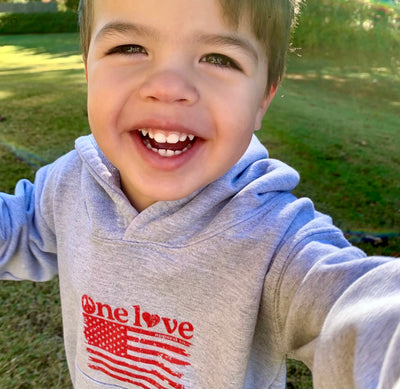Back to School, Not Back to Stress: Mental Health Tips That Actually Help

As the summer winds down and store shelves fill with school supplies, students and families alike begin preparing for the transition back to the classroom. But while backpacks and binders get all the attention, there’s one essential item that often gets overlooked: mental health.
At One Love Apparel, we believe mental wellness should be just as much a part of the back-to-school checklist as new shoes or sharpened pencils. Our cause-based apparel is designed to promote courage, kindness, and connection—because what students wear can do more than express style; it can start conversations that matter.
Whether a student is entering kindergarten or stepping into their senior year of high school, the emotional weight of the new school year can be significant. Anxiety about fitting in, academic pressure, social dynamics, identity exploration, and uncertainty about the future all play a role. And for many students, those concerns don’t fade once the bell rings.
In this post, we’re diving into practical, empowering mental health strategies that students, parents, and educators can use to start the school year strong, stay resilient through challenges, and support each other in meaningful ways.
1. Normalize the Nerves
Back-to-school anxiety is not only common—it’s completely normal. Whether it's the fear of not making friends, facing bullies, or just adjusting to a new environment, those feelings deserve to be acknowledged.
For students: Know that nervousness isn’t a flaw or weakness. It’s a sign that you care about what’s coming.
For parents and educators: Don’t dismiss kids’ worries as “just nerves.” Listen, validate, and offer reassurance without pressure. Phrases like “It’s okay to feel this way” go a long way.
2. Create (and Stick to) a Routine
Structure helps reduce anxiety. Predictable routines around sleep, meals, screen time, and homework can create a sense of stability and safety.
-
Before school starts: Practice morning and evening routines a week early.
-
During the school year: Use visual schedules, planners, or checklists to break tasks into manageable steps.
But remember: routines should reduce stress, not increase it. Build in breaks, fun, and flexibility.
3. Build a Mental Health Toolkit
Just like students pack a backpack with supplies, they should also carry strategies to support their mental well-being. Everyone’s toolkit looks different, but here are ideas:
-
Deep breathing techniques
-
Journaling or art
-
Music or movement breaks
-
Talking to a trusted friend or adult
-
Positive affirmations
-
Apps for mindfulness or mood tracking
Parents and teachers can help kids build these skills by modeling them and encouraging exploration. (Not every kid wants to meditate—some find clarity in soccer or sketching.)
4. Set Realistic Expectations
Perfectionism is a major source of stress. Students today face more pressure than ever to be exceptional at everything—grades, sports, social life, and future planning.
Instead of asking, "Did you get all As?" ask, "Did you try your best? What did you learn?" Shift the conversation from outcomes to effort, growth, and curiosity.
5. Watch for Warning Signs
Some stress is expected. But when anxiety, sadness, or isolation persist or worsen, it may be time to seek help.
Warning signs include:
-
Changes in sleep or appetite
-
Frequent stomachaches or headaches with no medical cause
-
Withdrawing from friends or activities
-
Sudden drops in academic performance
-
Increased irritability or anger
-
Expressing hopelessness or worthlessness
Open the door for honest conversations. Ask direct but caring questions: “Have you been feeling overwhelmed lately?” “Is something at school making you feel unsafe or unhappy?”
6. Encourage Connection
Loneliness is one of the biggest mental health challenges for students. One trusted friend can make all the difference.
-
Encourage participation in clubs, sports, or interest-based groups
-
Look for opportunities to mentor or be mentored
-
If you see someone sitting alone, say hi. Small gestures = big impact.
Parents: don’t underestimate the importance of helping kids nurture friendships. And educators: creating safe, inclusive spaces within classrooms can prevent isolation before it starts.
7. Address Bullying Head-On
Bullying—in person or online—can have devastating effects on mental health. It should never be dismissed as "just part of growing up."
-
Teach kids to recognize and report bullying
-
Encourage upstander behavior, not just bystander silence
-
Model zero tolerance for cruelty
-
Check in regularly: “Is anyone treating you unfairly at school or online?”
Schools that invest in kindness culture, peer support programs, and clear anti-bullying policies see measurable improvements in student well-being.
8. Speak Openly About Mental Health
When students hear mental health spoken about the same way as physical health, stigma fades. Normalize the language:
-
“I’m feeling anxious today”
-
“It’s been a stressful week”
-
“I’m taking a break to clear my head”
This helps students recognize their own feelings and feel safe asking for help. Parents and teachers should model this, too.
9. Celebrate Progress, Not Perfection
Growth isn’t always linear. A student might conquer math anxiety one week and feel overwhelmed the next. That’s normal.
Celebrate effort. Celebrate courage. Celebrate trying again. Help students see that progress in mental health is just as real (and worthy of praise) as academic wins.
10. Know When to Ask for Help
Mental health challenges are not a sign of weakness. Asking for help is an act of strength. If a student is struggling beyond what can be supported with coping strategies alone, it’s time to involve professionals.
Start with a school counselor, therapist, pediatrician, or mental health hotline. Parents and educators: you don’t have to have all the answers—you just have to be willing to help find them.
Final Thoughts: Starting Strong Means Starting Supported
As we fill backpacks and stock supply closets, let’s remember that the best foundation for academic success is emotional safety. When students feel supported, seen, and emotionally equipped, they thrive in and out of the classroom.
This school year, let’s make mental health part of the conversation from day one. Because bravery isn’t just raising your hand in class. It’s asking for help. It’s showing up when it’s hard. It’s being kind to yourself and others. And it’s believing that you are never alone.
At One Love Apparel, we believe in messages that matter. That’s why every collection we release is designed to promote courage, compassion, and connection—with a portion of proceeds donated to causes that support mental health, anti-bullying, and youth empowerment. So when you wear your values, you’re not just making a statement. You’re making a difference.



